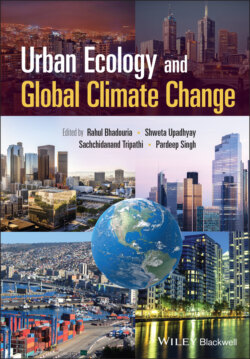Читать книгу Urban Ecology and Global Climate Change - Группа авторов - Страница 14
1.1 Introduction
ОглавлениеHumankind is facing three major challenges viz. human overpopulation, urbanisation, and climate change with the onset of the twenty‐first century (Steiner 2014). Presently, about seven billion (expected to reach 8.2 and 9 billion by 2025 and 2050, respectively) people are inhabiting the Earth which is more than any previous time. Urban areas and people living in the cities are increasing rapidly in size, globally (Mitchell et al. 2018). Over half (~54%) of the world's population is residing in the urban areas which is expected to grow to 60 and 80% by the year 2030 and 2050, respectively (Lee 2011; Vasishth 2015). Urbanisation phenomenon can be seen occurring on all the continents (except Antarctica); however, rapid urbanisation is happening, particularly in the Asia and Sub‐Saharan Africa (Yu et al. 2017). Rapid urbanisation is putting severe stress on the planet Earth resulting in changes in the ecosystems from the landscape to the global scales (Steiner 2014; Colding and Barthel 2017). Urbanisation leads to the rapid conversion of natural pervious land surfaces to various impervious surfaces in the built forms like buildings and roads which resulted in changes in many ecosystem functions such as water infiltration and availability, species composition, soil properties, and thermal properties of the surfaces (Gaston et al. 2010; Seto et al. 2012; Yu et al. 2017). Urbanisation has not only affected the tangible features of the natural ecosystems but also resulted in the modifications of intangible aspects such as biogeochemical cycling and climate change (Kattel et al. 2013; Mitchell et al. 2018). Therefore, need for the proper planning and designing of the urban ecosystems has been arisen for reducing the ecological footprints (on per capita basis) of these ecosystems for managing the trio of challenges mentioned in the opening line of this chapter (Steiner 2014; Vasishth 2015).
Urban ecosystems are not only the rich nodes of civilisation but also have become the engines of development and divers of various environmental changes even at fine spatial scales (Kattel et al. 2013; Verma et al. 2020a). Urban ecosystems are characterised by intensive human population and its supportive infrastructures such as built‐up areas in the form of cities, towns, and megacities, developed by profound changes in the landscape structures and energy processes at the cost of natural ecosystems (Forman 2014; Jaganmohan et al. 2016; Yu et al. 2017; Mitchell et al. 2018; Verma et al. 2020a). The urban ecosystems are highly heterogeneous and fragile systems, which are facing many challenges due to massive human interferences (Ma et al. 2020). Since humans represent the core of urbanisation's structural processes, their activities related to aesthetic values, goods and services (food and water), energy and waste generation, and recycling are the driving factors of all the changes occurring in these ecosystems (Carpenter and Folke 2006; Chapin et al. 2011; Kattel et al. 2013). Thus, urban ecosystems are the complex ecosystems characterised by the interplays of socio‐economic dimensions and biophysical (natural processes) interactions occurring at various spatio‐temporal scales (Kattel et al. 2013; Ma et al. 2020). Most notably, the land‐use change and the infrastructural development by the human decide the future of the urban ecosystems which are already facing various unprecedented social, demographic, technological, and environmental challenges (Niemelä 2014; Steiner 2014). Thus, there comes the need to understand the urban ecosystems as an ecological system which can play and sustain even under the human dominance (Grimm et al. 2008). In the next sub‐section, the concept of urban ecology and its need for the sustainable urban development has been highlighted.
